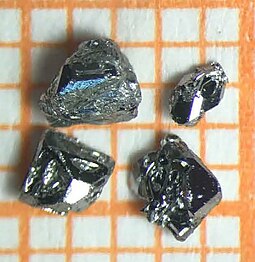Intermetallic

An intermetallic (also called intermetallic compound, intermetallic alloy, ordered intermetallic alloy, long-range-ordered alloy) is a type of metallic alloy that forms an ordered solid-state compound between two or more metallic elements. Intermetallics are generally hard and brittle, with good high-temperature mechanical properties.[1][2][3] They can be classified as stoichiometric or nonstoichiometic intermetallic compounds.[1]
Although the term "intermetallic compounds", as it applies to solid phases, has been in use for many years,
Definitions
Research definition
Schulze in 1967[5] defined intermetallic compounds as solid phases containing two or more metallic elements, with optionally one or more non-metallic elements, whose crystal structure differs from that of the other constituents. Under this definition, the following are included:
- Electron (or Hume-Rothery) compounds
- Size packing phases. e.g. Laves phases, Frank–Kasper phases and Nowotny phases
- Zintl phases
The definition of a metal is taken to include:
- post-transition metals, i.e. aluminium, gallium, indium, thallium, tin, lead, and bismuth.
- metalloids, e.g. silicon, germanium, arsenic, antimony and tellurium.
Homogeneous and heterogeneous
are excluded under this definition. However, interstitial intermetallic compounds are included, as are alloys of intermetallic compounds with a metal.Common use
In common use, the research definition, including
Complexes
The term intermetallic is used[6] to describe compounds involving two or more metals such as the cyclopentadienyl complex Cp6Ni2Zn4.
B2
A B2 intermetallic compound has equal numbers of atoms of two metals such as aluminium and iron, arranged as two interpenetrating simple cubic lattices of the component metals.[7]
Properties and applications
Intermetallic compounds are generally brittle at room temperature and have high melting points. Cleavage or intergranular fracture modes are typical of intermetallics due to limited independent
| Intermetallic Compound | Melting Temperature
(°C) |
Density
(kg/m3) |
Young's Modulus (GPa) |
|---|---|---|---|
| FeAl | 1250-1400 | 5600 | 263 |
| Ti3Al | 1600 | 4200 | 210 |
| MoSi2 | 2020 | 6310 | 430 |
Examples
- niobium-tin
- nickel metal hydride batteries)
- Nitinol(NiTi)
- Coating materials e.g. NiAl
- High-temperature structural materials e.g. nickel aluminide, Ni3Al
- Dental amalgams, which are alloys of intermetallics Ag3Sn and Cu3Sn
- Laves phases (AB2), e.g., MgCu2, MgZn2 and MgNi2.
The formation of intermetallics can cause problems. For example,
Intermetallic particles
Intermetallic particles often form during solidification of metallic alloys, and can be used as a dispersion strengthening mechanism.[1]
History
Examples of intermetallics through history include:
- Roman yellow brass, CuZn
- Chinese high tin bronze, Cu31Sn8
- Type metal, SbSn
- Chinese white copper, CuNi [11]
German type metal is described as breaking like glass, not bending, softer than copper but more fusible than lead.[12] The chemical formula does not agree with the one above; however, the properties match with an intermetallic compound or an alloy of one.[citation needed]
See also
- Complex metallic alloys
- Kirkendall effect
- Maraging steel
- Metallurgy
- Solid solution
References
- Gerhard Sauthoff: Intermetallics, Wiley-VCH, Weinheim 1995, 165 pages
- Intermetallics, Gerhard Sauthoff, Ullmann's Encyclopedia of Industrial Chemistry, Wiley Interscience. (Subscription required)
- ^ )
- OCLC 906692179.
- OCLC 300921090.
- ^ Hume-Rothery, W. (1955) [1948]. Electrons, atoms, metals and alloys (revised ed.). London: Louis Cassier Co., Ltd. pp. 316–317 – via the Internet Archive.
- ^ G. E. R. Schulze: Metallphysik, Akademie-Verlag, Berlin 1967
- ISBN 0-471-19957-5
- ^ "Wings of steel: An alloy of iron and aluminium is as good as titanium, at a tenth of the cost". The Economist. February 7, 2015. Retrieved February 5, 2015.
E02715
- OCLC 300921090.
- ^ S.P. Murarka, Metallization Theory and Practice for VLSI and ULSI. Butterworth-Heinemann, Boston, 1993.
- ^ Milton Ohring, Materials Science of Thin Films, 2nd Edition, Academic Press, San Diego, CA, 2002, p. 692.
- ^ "The Art of War by Sun Zi: A Book for All Times". China Today. Archived from the original on 2005-03-07. Retrieved 2022-11-25.
- ^ [1] Type-pounding The Penny Cyclopædia of the Society for the Diffusion of Useful Knowledge By Society for the Diffusion of Useful Knowledge (Great Britain), George Long Published 1843
External links
- Intermetallics, scientific journal
- Intermetallic Creation and Growth – an article on the Wire Bond Website of the NASA Goddard Space Flight Center.
- Intermetallics project (IMPRESS Intermetallics project at the European Space Agency)
- Video of an AB5 intermetallic compound solidifying/freezing
